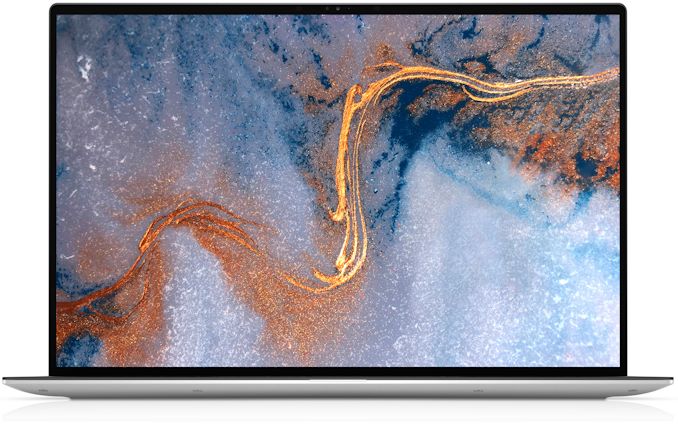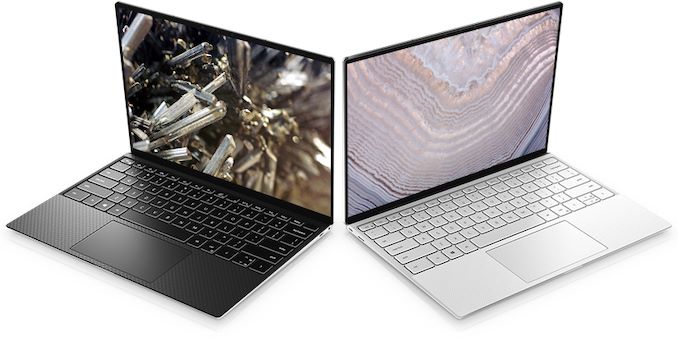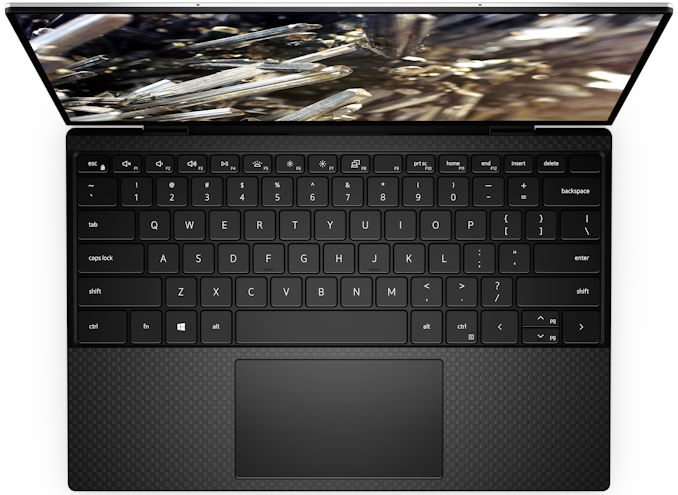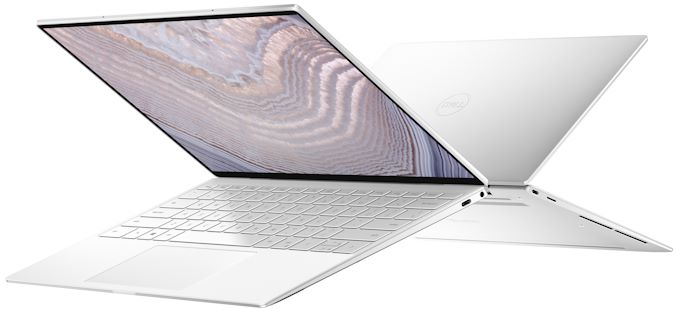Dell’s 2020 XPS 13 (9300) Gets Ice Lake & A 13.4-Inch Ultra-HD+ Display
by Anton Shilov on January 2, 2020 9:00 AM EST
Ahead of next week's 2020 CES, Dell has introduced a new version of its ultra-portable XPS 13 notebook that is based on Intel’s 10th Gen Core ‘Ice Lake’ processor. The new XPS 13 machines will offer higher graphics performance than predecessors powered by Intel's Comet Lake CPUs, but the latter offer more general-purpose processing cores. Meanwhile, Dell is also giving the XPS 13 a display upgrade to go with the new Ice Lake processors, reformatting the laptop to use larger 16:10 displays, with a resolution increase to match. Overall, the Comet Lake and Ice Lake versions of the XPS 13 PCs will co-exist on the market, so users will have a choice.
The Dell XPS 13 9300-series laptops are aimed at people looking for maximum performance in a rather unique 13.4-inch form-factor, so in addition to Intel’s Ice Lake CPU with built-in Iris Plus Graphics, they can pack up to 32 GB LPDDR4X-3733 of memory as well as an up to 2 TB PCIe SSD. To cool down the processor and ensure its consistent performance under high loads, Dell used a new cooling system with two fans, two heat pipes, and multiple air inlets. As for connectivity, the system has a 2x2 Killer Wi-Fi 6 + Bluetooth 5.0 adapter, two Thunderbolt 3 ports, a microSD card reader, and a 3.5-mm audio jack.
As previously mentioned, Dell is also using this opportunity to include a slightly larger display on their latest XPS 13 laptops. The newest edition of the laptop makes the move to 16:10 aspect ratio panels – an increasingly popular option for high-end laptops these days – with the overall panel size increasingly slightly to 13.4 inches diagonal. Dell in turn is offering two panels: a 1920x1200 panel with full sRGB coverage, or a 3840x2400 "Ultra-HD+" panel with support for 90% of the DCI-P3 space as well as HDR 400 certification. Both panels are Dolby Vision certified as well.
To outfit the XPS 13 with a larger panel, Dell has both worked to shrink the bezel around the panel as well as enlarging the laptop overall. The notebook comes in a black or white CNC-machined aluminum chassis that is 14.8 mm thick (vs. up to 11.6 mm) and weighs 1.2 kg – 1.27 kg depending on the touch support. The net result is that the laptop has a volume about 25% greater, mostly due to being 3.2mm thicker.
Traditionally for Dell XPS-branded laptops, the new XPS 13 boasts rather advanced multimedia capabilities, including a 720p webcam, 2W stereo speakers with Waves MaxxAudio Pro enhancements, and a far-field Microsoft Cortana-capable microphone array. As for security, the new XPS 13 has a Windows Hello-compliant fingerprint reader in the power button.
The new XPS 13 will come equipped with a 52 Wh battery rated for up to 19 hours of operation in case of models equipped with a Full-HD+ display.
| Specifications of the Dell XPS 13 9300-Series | |||
| General Specifications | |||
| LCD | Diagonal | 13.4-inch | |
| Resolution | 1920×1200 | 3840×2400 | |
| Brightness | 400 cd/m² | 500 cd/m² | |
| Contrast Ratio | 1800:1 | 1500:1 | |
| Color Gamut | 100% sRGB | 100% sRGB 99% DCI-P3 |
|
| Features | Dolby Vision | Dolby Vision | |
| Touch Support | with or without touch | Yes | |
| Protective Glass | Corning Gorilla Glass 6 in case of touch-enabled model | ||
| CPU | Intel Core i3 1005G1 (4MB cache, up to 3.4GHz) Intel Quad Core i5 1035G1 (6MB cache, up to 3.6GHz) Intel Quad Core i7 1065G7 (8MB cache, up to 3.9GHz) |
||
| Graphics | Intel UHD Graphics Intel Iris Plus Graphics |
||
| RAM | 4 - 32 GB LPDDR4X-3733 DRAM (soldered/onboard) | ||
| Storage | 256 GB PCIe 3.0 x4 SSD 512 GB PCIe 3.0 x4 SSD 1 TB PCIe 3.0 x4 SSD 2 TB PCIe 3.0 x4 SSD |
||
| Wireless | Killer AX1650 Wi-Fi 6 + Bluetooth 5.0 (based on Intel's silicon) Killer AX500 Wi-Fi 6 + Bluetooth 5.0 (based on Qualcomm's silicon) |
||
| USB | 3.1 | 2 × TB 3/USB Gen 3.1 Gen 2 Type-C | |
| 3.0 | - | ||
| Thunderbolt | 2 × TB 3 (for data, charging, DP displays) | ||
| Cameras | Front | 720p HD webcam | |
| Other I/O | Microphone, 2 stereo speakers, audio jack | ||
| Battery | 52 Wh | ||
| Dimensions | Width | 295.7 mm | 11.64 inches | |
| Depth | 198.7 mm | 7.82 inches | ||
| Thickness | 14.8 mm | 0.58 inches | ||
| Weight | non-touch 1.2 kilograms | 2.64 pounds touch-enabled 1.27 kilograms | 2.8 pounds |
||
| Launch Price | Starting at $999.99 | ||
Dell’s new XPS 13 will be available in the US and select European countries on January 7 with prices starting at $999.99. In other regions, the laptop will hit the shelves in February. In addition to Windows 10-based versions of of the new XPS 13, Dell will offer Linux-powered models.
Related Reading:
- Dell Unveils Updated XPS 13 with Intel’s 10th Gen Core CPUs & 4K Panel
- Dell Launches XPS 15 7590: Up to 5 GHz and Overclockable, 15.6-Inch OLED
- Dell’s XPS 13 2-in-1 7390 Available: Intel’s 10th Gen Core CPUs Inside
- When Ice Matters: Dell Announces XPS 13 2-in-1 with Ice Lake-U
Source: Dell














39 Comments
View All Comments
PeachNCream - Thursday, January 2, 2020 - link
I still don't really understand the logic behind including Killer-branded adapters as opposed to just using the Intel NIC upon which it was based. The software and driver don't add any value to the product given their lack of relevant features or real world performance benefits and since very few companies continue to include Killer NICs, there isn't a lot of name recognition to be gained (and possibly some to be lost given the reputation those network cards have earned over the last decade plus).Alistair - Thursday, January 2, 2020 - link
funny anecdote: coworker was fired when he couldn't get the CEO's laptop wifi on the new XPS 15 to work right (sadly I was not there to tell him about Killer wireless cards immediately should be replaced with Intel ones)xaml - Friday, May 29, 2020 - link
That does not seem particularly funny to me, neither is the one that I could share about the soldered random access memory of my model from seven years ago. It seems to have accumulated a certain degree of faultiness. I want an antidote, I need no anecdote. The absurdity is that, with the accumulator which died and which I removed and which can be replaced, while some might even ignore the handrest coating which is beginning to wear out in two frontal areas presumably because of usage and cleaning, as a whole it remains usable. The memory though, it may be like the senseless emaciation of being unable to move amidst an unpredictable sea level.Dug - Thursday, January 2, 2020 - link
It's just an Intel chipset. The Dell XPS 13 2-in-1 that I have doesn't even mention Killer software on it, just Intel.Reflex - Thursday, January 2, 2020 - link
I just removed the Killer software and force installed the Intel AX200 drivers on my XPS 13 2-in-1 and it works great.Retycint - Thursday, January 2, 2020 - link
Important point to note: The removable SSD makes a return, after being MIA on the previous model (7390). So no need to get ripped off by Dell's storage pricings when you can swap in a 1TB SSD for $100-120jeremyshaw - Thursday, January 2, 2020 - link
It was present in the regular 7390 laptop, though missing in the 7390 2in1 (which already has Ice Lake).That being said, the internal layout and configuration of this new laptop is much more similar to the 7390 2in1 than the regular 7390. This hopefully bodes well for the future 7390 2in1 replacement!
Retycint - Thursday, January 2, 2020 - link
I stand corrected. Always thought both laptops had soldered ssds for some reason. Hopefully the 2-in-1 also moves to a removable oneskavi - Thursday, January 2, 2020 - link
> The notebook comes in a black or white CNC-machined aluminum chassis that is 14.8 mm thick (vs. up to 11.6 mm) and weighs 1.2 kg – 1.27 kg depending on the touch support. The net result is that the laptop has a volume about 25% greater, mostly due to being 3.2mm thicker.what laptop are you comparing to here? I don't see it specified in the article.
skavi - Thursday, January 2, 2020 - link
nm it's vs the older version. Interesting that the thickness has increased despite the battery size remaining constant. Hopefully points to some very beefy cooling (though the previous model's was already very good).The Verge reported that this model is actually 2% smaller than the previous gen. Is that just in terms of length * width?